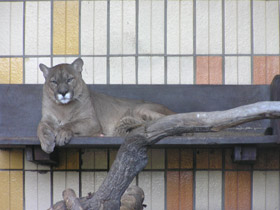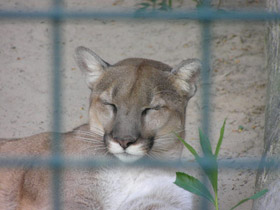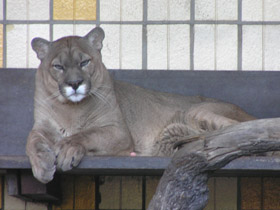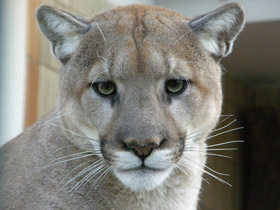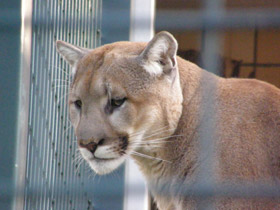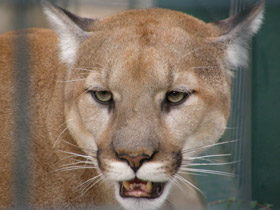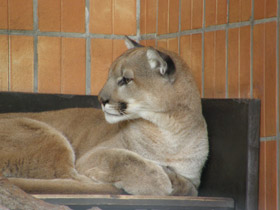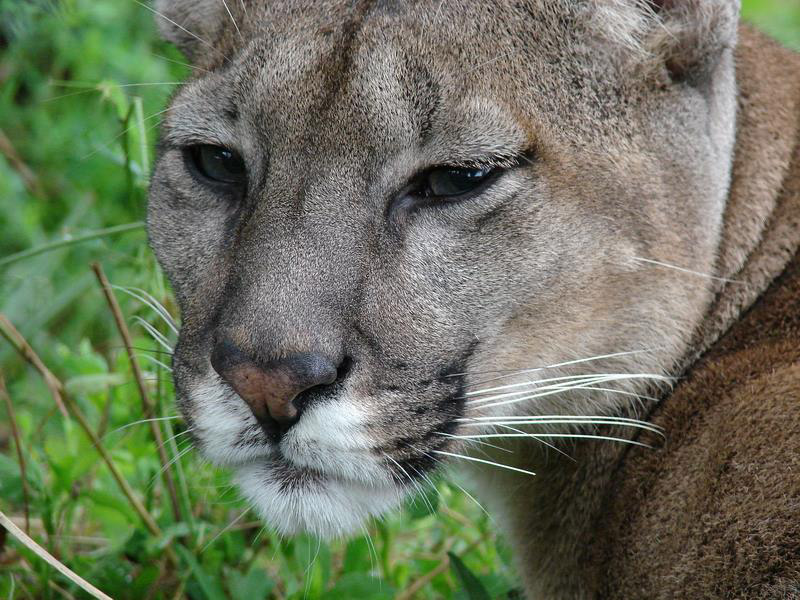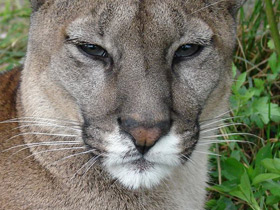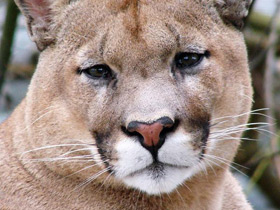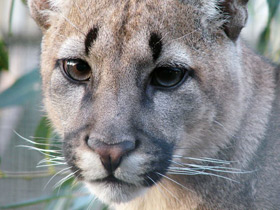The cougar (Puma concolor), the puma, mountain lion, catamount, or panther
The cougar (Puma concolor) (/ˈkuːɡər/, KOO-gər), also known as the puma, mountain lion, catamount, or panther, is a large cat native to the Americas, second in size only to the stockier jaguar. They are not technically grouped with the "true" big cats, as they are slightly smaller than other big cats, and they lack the vocal physiology to roar (unlike lions, tigers, leopards, and jaguars).
Habitat area
Puma concolor is a carnivorous mammal of the family Felidae. This American big cat is also called puma or mountain lion, as the two species were once thought to be related. It was later decided that, genetically, the cougar was closer to the small cat and was assigned to the genus Felis, but since 1993 it has been classified as a separate genus.
Zoologists now believe that the puma's closest relatives are jaguars. The word "puma" comes from the Quechua language.
This carnivore is widespread in southwestern Alaska, central Canada, the United States and Central and South America, where it is found at various altitudes - from plains to mountains 4,700 m above sea level - and in a variety of habitats: tropical and mountain pine forests, grassy plains, pampas and humid lowlands.
Appearance and behaviour
The Puma concolor resembles a panther, although it is more graceful and is the second largest member of the American cat family (only the jaguar is larger). This cat can reach a length of 100-180 cm, with a height at the withers of 61-76 cm and a weight of up to 105 kg (males).
The usual male of the large subspecies weighs 70-90 kg, females are 30% smaller. The Puma concolor has a strong, elongated and flexible body, a small head with small round ears and short, strong legs. Its feet are broad, with inlaid sharp claws; its tail is long (60-75 cm), muscular, strong and evenly pubescent, with a small tassel at the tip. The retractile claws are used to grasp and hold prey and to climb trees. These animals are perfectly adapted to life in difficult terrain. Thanks to their muscular limbs, they are able to jump up to 6 m in length and 2.5 m in height and to run at speeds of up to 50 km/h (albeit over short distances).
The Puma concolor moves easily on mountain slopes, climbs trees and rocks very well and swims well if necessary.
Its long 4 cm fangs are used to grasp prey and pierce its skin and muscles, while its smaller incisors are used to remove hair or feathers from prey. The cat's strong teeth are adapted to tear tissue and break bones.
The coat of the Puma concolor is thick, short and coarse, always of a uniform colour - greyish-yellow or yellow-brown (hence the Latin name concolor, which translates as "single-coloured").
Lifestyle and nutrition
The puma concolor leads a strictly solitary lifestyle (except for a few days during the rutting season and mothers with their kittens). Its population density depends on the availability of game and varies from one animal per 85 km² to 13 animals per 54 km². The female puma's hunting ground occupies 26 to 350 km² and is usually on the periphery of the male's territory. Male home ranges range from 140 to 760 km² and never overlap. Territory boundaries are marked by urine and faeces, as well as by scratches on trees. The Puma concolor hunts mainly at dusk.
Its diet consists of ungulates: black-tailed, white-tailed and American red deer, moose, caribou, wild pigs and cattle. However, Puma concolor can eat a wide variety of animals, from mice and squirrels, opossums, rabbits, muskrats, beavers, raccoons, skunks and armadillos to crocodiles, coyotes and bobcats. They also eat birds, fish and even snails and insects.
When hunting, the Puma concolor often uses the element of surprise: it sneaks up on large prey, then jumps on its back at close range and snaps its neck.
Predators hide uneaten meat by dragging it away and covering it with leaves, bushes or snow. They return to their hidden prey, sometimes repeatedly. The Puma concolor is capable of dragging a carcass 5 to 7 times its weight a considerable distance. Indians took advantage of this habit of the Puma concolor by picking up carcasses that had been eaten or left untouched.
Reproduction
Before giving birth to her young, the female seeks an isolated place, usually a cave or dense bush. Gestation lasts between 82 and 95 days and usually gives birth to 2 to 6 cubs, weighing about 430 g and measuring 30 cm. Puma cubs are coloured differently from adults: their fur is thicker, covered with darker patches, stripes on the front and hind legs, and rings on the tail. The spots on their coat begin to fade from the age of 9 months and disappear completely by the age of 2 years.
The pups' eyes open two weeks after birth. Their eyes are initially blue, but gradually change to brown or amber after six months.
At 10 days of age, the kittens' teeth begin to erupt and their ears open. When they are six weeks old, they begin to eat adult food, but still receive milk. At this time, the female has to give three times the usual amount of prey.
The young stay with their mother until they are 15-26 months old, and then go off to find their own hunting grounds, although they may stay in a group for a few more months after leaving their mother. Females reach sexual maturity at 2.5 years and males at 3 years.
The puma concolor is hunted by locals because of attacks on livestock. In the USA, a considerable premium used to be paid for a dead cougar, but hunting of Puma concolor is now restricted in many states.
Naming and etymology
The word cougar is borrowed from the Portuguese çuçuarana, via French; it was originally derived from the Tupi language. A current form in Brazil is suçuarana. In the 17th century, Georg Marcgrave named it cuguacu ara. Marcgrave's rendering was reproduced in 1648 by his associate Willem Piso. Cuguacu ara was then adopted by John Ray in 1693. In 1774, Georges-Louis Leclerc, Comte de Buffon converted cuguacu ara to cuguar, which was later modified to "cougar" in English.
The cougar holds the Guinness record for the animal with the greatest number of names, with over 40 in English alone. "Puma" is the common name used in Latin America and most parts of Europe. The term puma is also sometimes used in the United States. The first use of puma in English dates to 1777, introduced from Spanish from the Quechua language. In the western United States and Canada, it is also called "mountain lion", a name first used in writing in 1858. Other names include "panther" (although it does not belong to the genus Panthera) and "catamount" (meaning "cat of the mountains").
Taxonomy and evolution
Felis concolor was the scientific name proposed by Carl Linnaeus in 1771 for a cat with a long tail from Brazil. The second half of the name, "concolor" is Latin for "of uniform color". It was placed in the genus Puma by William Jardine in 1834. This genus is part of the Felinae. The cougar is most closely related to the jaguarundi and the cheetah.
Subspecies
Following Linnaeus's first scientific description of the cougar, 32 cougar zoological specimens were described and proposed as subspecies until the late 1980s. Genetic analysis of cougar mitochondrial DNA indicate that many of these are too similar to be recognized as distinct at a molecular level, but that only six phylogeographic groups exist. The Florida panther samples showed a low microsatellite variation, possibly due to inbreeding. Following this research, the authors of Mammal Species of the World recognized the following six subspecies in 2005:
- Puma concolor concolor (Linnaeus, 1771) includes the synonyms bangsi, incarum, osgoodi, soasoaranna, sussuarana, soderstromii, suçuaçuara, and wavula;
- Puma concolor puma (Molina, 1782) includes the synonyms araucanus, concolor, patagonica, pearsoni, and puma (Trouessart, 1904);
- Puma concolor couguar (Kerr, 1792) includes arundivaga, aztecus, browni, californica, floridana, hippolestes, improcera, kaibabensis, mayensis, missoulensis, olympus, oregonensis, schorgeri, stanleyana, vancouverensis, and youngi;
- Puma concolor costaricensis (Merriam, 1901);
- Puma concolor anthonyi (Nelson and Goldman, 1931) includes acrocodia, borbensis, capricornensis, concolor, greeni, and nigra;
- Puma concolor cabrerae Pocock, 1940 includes hudsonii and puma proposed by Marcelli in 1922.
In 2006, the Florida panther was still referred to as a distinct subspecies P. c. coryi in research works.
As of 2017, the Cat Classification Taskforce of the Cat Specialist Group recognizes only two subspecies as valid:
- Puma concolor concolor in South America, possibly excluding the region northwest of the Andes;
- Puma concolor couguar in North and Central America and possibly northwestern South America.
Conservation
The cougar has been listed as Least Concern on the IUCN Red List since 2008. However, it is also listed on CITES Appendix II. Hunting it is prohibited in California, Costa Rica, Honduras, Nicaragua, Guatemala, Panama, Venezuela, Colombia, French Guiana, Suriname, Bolivia, Brazil, Chile, Paraguay, Uruguay and most of Argentina. Hunting is regulated in Canada, Mexico, Peru and the United States. Establishing wildlife corridors and protecting sufficient range areas are critical for the sustainability of cougar populations. Research simulations showed that it faces a low extinction risk in areas larger than 2,200 km2 (850 sq mi). Between one and four new individuals entering a population per decade markedly increases persistence, thus highlighting the importance of habitat corridors.

















